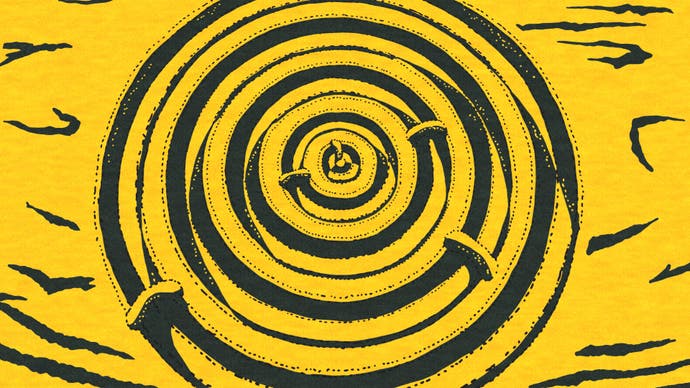Phoenix Springs review - fascinating, frustrating neo-noir surrealism
Logic problem.
Phoenix Springs doesn't so much start as awaken, adrift in a shimmering void of static to an only slightly discordant choral swell. And that's just the title screen. Developer and art collective Calligram Studio's debut project is an astonishingly assured piece of work, presenting a constantly, hypnotically churning world of loosely sketched lines, pitch-black shadows, and stark primary hues that's part queasy expressionist nightmare, part perpetually receding dream. It's a game of striking jump cuts and slick transitions, of rich diegetic soundscapes underscored by threatening synthetic thrums. Even its protagonist's ever-present narration crackles and whispers as if broadcast through a transistor radio picking up a signal from another realm.
Phoenix Springs is thick with atmosphere; haunting, disorientating, and at times intense to the point of suffocating. It's also a game with a keen sense of identity, and it paints its vision of a fascinating future dystopia with exquisite economy. "Government issued, I can search my personal files plus a few public databases," protagonist Iris Dormer barks of her computer early on, the unspoken implications left to linger. "Actually, a video feed," she matter-of-factly observes of a wall mirror. "Harvesting data, I'm sure."
Even before you've stepped out into the rain-battered city in search of Iris' estranged younger brother Leo - even before you've seen the ransacked university full of whacked-out ravers chasing a sleep-deprivation high, or the eight-foot concrete walls surrounding houses on filthy streets, or the blankly uncomprehending homeless orphans in thrall of their biotech toys - it's clear something, somewhere has gone terribly awry. But Calligram Studio stops at the broad strokes, trusting its audience to fill in the blanks with their own bleakly pessimistic detail.
In fact, Phoenix Springs' idiosyncratic presentation is so singular, it comes as something of a surprise to discover that, mechanically, it's a fairly traditional point-and-click adventure at heart. Albeit one where tech reporter Iris' inventory steadily fills not with tangible objects but ideas and investigatory leads. At first, only Leo's name sits at the centre of the minimalist UI representing her thoughts, but clues can be combined with other elements in the world, queried directly by Iris, or brought into conversations - opening up new avenues for investigation, even if they might ultimately prove to be red herrings and dead ends.
Phoenix Springs' first act is a wonderfully taut bit of neo-noir mystery, engagingly structured in a way that feels like you're organically teasing out clues in a world reluctant to give up its secrets. It's driven by a real sense of purpose and tangible progression, carefully seeding hints toward the wider mysteries of the world. And it's all brought to life by Iris' terse yet strikingly evocative first-person, present-tense narration - delivered in mesmerisingly staccato monotone ("Eccentric posture," she remarks of one character, "stroking petals as if coaxing an alley cat"). But then come the fateful words, whispered from the lips of a chronological impossibility, "Don't go to Phoenix Springs", and things take a dramatic turn.




Once Iris disembarks the train at the titular oasis - a vast stretch of verdant green in the heart of a sun-blasted desert - tangible reality becomes an elusive dream. It's here Phoenix Springs jettisons the compelling narrative propulsion and clear-eyed focus of its early mystery, becoming more of a confounding, disorientating mood piece. Gone is the oppressive, if comfortingly familiar shape of the city, replaced by a world of indeterminate time and technology, of ancient ruins and carefully tended orchards, where geography and symbolism become indistinguishable, and where its inhabitants aren't so much people as distant reflections of themselves - forever spouting airy, enigmatic dialogue that rapidly becomes exhausting in its evasiveness. "Puzzling trains of thought, non-sequiturs, irrelevant answers," comments Iris on logic's increasing unmooring.
As it slides into its second half, Phoenix Springs becomes so stubbornly enigmatic, so perpetually withholding, so narratively aloof, it's increasingly difficult to find an emotional or intellectual foothold, and it's not easy to remain engaged with the exasperating nothingness of it all. Its pace turns languid, seemingly directionless, only enlivened by sporadic moments of frenzied revelation, and its puzzle design - fittingly but unhelpfully - adopts the logic of a dream. It's here, when progress could conceivably be tied to any one of the wilfully abstruse characters sprawled across the world or tucked away in the most random of conversational avenues, when confusion and increasingly arduous trial-and-error backtracking become the norm, and when progress is most frequently defined by investigatory dead ends, that Phoenix Springs is at its most intolerable. Yet, given Iris' similarly mounting frustration ("Another sock puppet spewing out nonsense," she sighs at one point; "These people can't help being unhelpful," she irritatedly notes elsewhere), it's clearly at least somewhat by design.




In its second half, Phoenix Springs isn't an easy game to love, or even particularly like. And yet, as it meandered toward its wilfully inconclusive denouement, it got under my skin enough, buzzed around in my brain enough, that I almost immediately played through it again. Its final revelation - its whole structure in fact - suggests a game meant to be revisited, reinterrogated, and picked apart for previously missed leads (even after two playthroughs, Steam tells me I've only seen around 30 percent of possible clue combinations). And recontextualised, there's at least some clarity to be found in its metaphysical swirl. The world-building in Phoenix Springs' first half - the talk of protest and ethics, the recurring motifs of eyes, knowledge, and immortality, of memory and self - gains new significance, and even the shapeless utterings and elusive symbolism of its latter half begin to take on some semblance of meaning and form.
In the end, though, I suspect the promise of true revelation is just another kind of illusion, dooming players to a fate in parallel with Phoenix Springs' story - a fruitless search for answers in a world made only of questions, going around and around and around. Does that make for an entirely rewarding game? Probably not, but it makes for one hell of an interesting one.
A copy of Phoenix Springs was provided for review by Calligram Studio.


